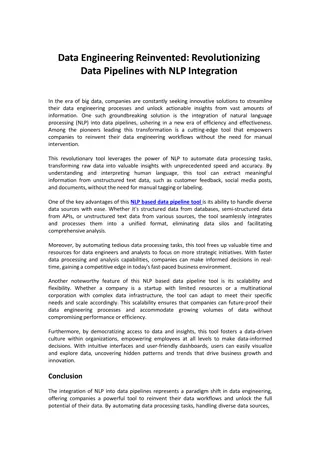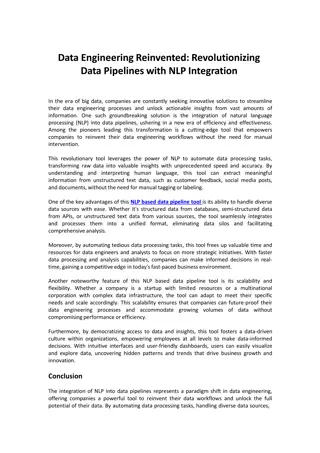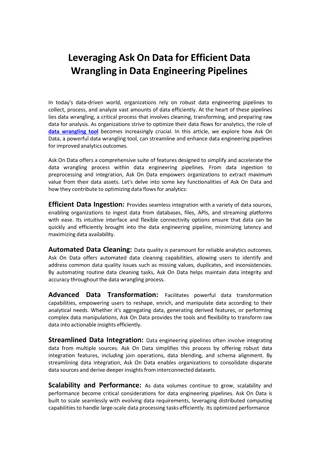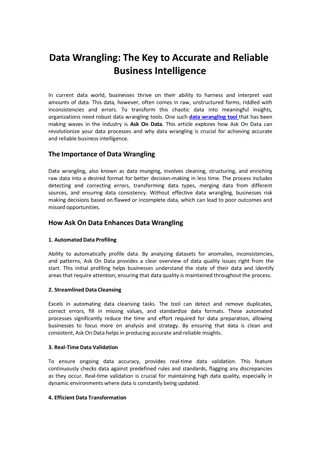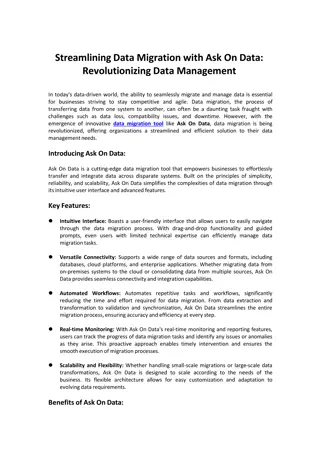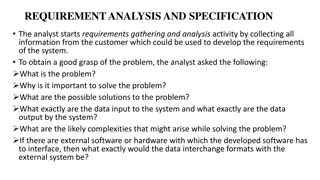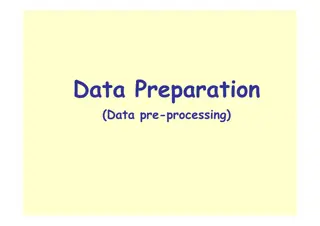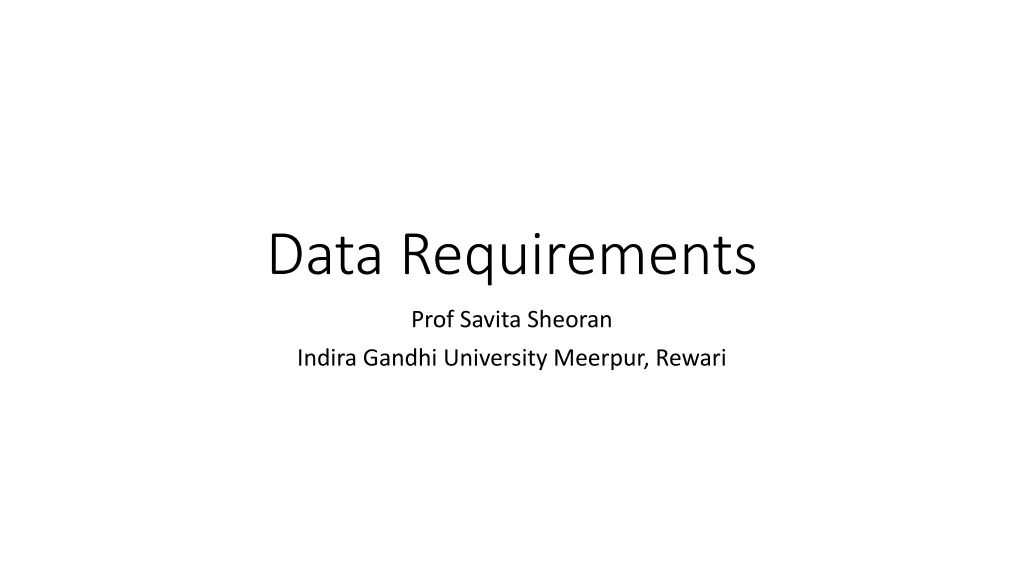
Understanding Data Requirements in Data Science for Accurate Analysis
Explore the crucial data requirements in data science for accurate modeling and analysis. Learn about data quantity, quality, type, structure, relevance, completeness, consistency, variety, distribution, temporal considerations, security, and privacy. Ensure your data meets these criteria for successful data-driven insights and decisions.
Download Presentation

Please find below an Image/Link to download the presentation.
The content on the website is provided AS IS for your information and personal use only. It may not be sold, licensed, or shared on other websites without obtaining consent from the author. If you encounter any issues during the download, it is possible that the publisher has removed the file from their server.
You are allowed to download the files provided on this website for personal or commercial use, subject to the condition that they are used lawfully. All files are the property of their respective owners.
The content on the website is provided AS IS for your information and personal use only. It may not be sold, licensed, or shared on other websites without obtaining consent from the author.
E N D
Presentation Transcript
Data Requirements Prof Savita Sheoran Indira Gandhi University Meerpur, Rewari
Introduction In data science, the success of an analysis or model is highly dependent on the quality and type of data available. Understanding the data requirements is crucial for ensuring that your models are accurate, reliable, and actionable. These requirements are not only about the amount of data but also the type, quality, and structure of the data. Here s a detailed breakdown of the data requirements in data science with examples
Cont.. 1. Data Quantity 2. Data Quality 3. Data Type and Structure 4. Data Relevance 5. Data Completeness and Handling Missing Data 6. Data Consistency Across Sources 7. Data Variety 8. Data Distribution 9. Temporal Data Considerations 10. Data Security and Privacy
Data Quantity Data Quantity Explanation: Volume of data refers to the size of the dataset. The more data you have, the better your model can learn patterns and make accurate predictions, especially for complex models like deep learning. However, more data does not always mean better results. The data should also be relevant and high quality. A large dataset full of noise may not improve performance. Example: Image Classification: In deep learning tasks such as image classification (e.g., cats vs. dogs), thousands or millions of labeled images may be required to build a reliable model. Time-Series Prediction: If you re forecasting stock prices, you would need historical data spanning years to understand seasonal trends, market conditions, and other factors.
Data Quality Quality of the data is paramount. Data must be accurate, complete, and consistent. Poor data quality can lead to garbage in, garbage out (GIGO), where bad data leads to inaccurate predictions or insights. Key elements of data quality: Accuracy: Data should reflect the real-world scenario without errors. Completeness: The dataset should not have missing or incomplete entries. Consistency: Data should be standardized and free from discrepancies. Example: Customer Churn Prediction: If you are predicting customer churn for a telecom company and some of the customers' data, like age or usage statistics, are missing or incorrectly entered (e.g., negative usage values), the model might perform poorly.
Data Type and Structure Data Type and Structure Explanation: The type and structure of data determine how it can be processed and what kind of models can be used. Structured Data: Data that is well-organized in rows and columns, like in databases or spreadsheets. Unstructured Data: Data that doesn t have a predefined structure, like text, images, or videos. Semi-structured Data: Data that doesn t fit neatly into a table but has some organization, like JSON or XML files. The right data format and structure are essential for applying appropriate preprocessing techniques and choosing the right algorithms. Structured Data: A customer database with columns like Customer ID, Name, Age, Purchase History, and Churn Status. This type of data can be used directly in traditional machine learning models (like regression or decision trees)
Cont.. Unstructured Data: A collection of customer reviews in text format. To analyze this, you would need natural language processing (NLP) techniques to transform the text into usable features. Semi-structured Data: A series of log files that are in a JSON format. While the structure is not tabular, the log entries have consistent fields, which can be parsed and analyzed.
Data Relevance The data should be relevant to the problem you are trying to solve. Irrelevant data can introduce noise, making it harder for your model to learn meaningful patterns. Feature selection is an important step in ensuring that only relevant data is used for analysis or modeling. Example: If you're trying to predict a customer s likelihood to buy a product, including irrelevant features like the customer s favorite movie genre or their birth month might negatively affect the model s performance
Data Completeness and Handling Missing Data Missing data is a common problem in data science. Sometimes not all features or observations are available, which can introduce bias or reduce the accuracy of models. Example: Healthcare Data: If some patient records are missing certain variables (e.g., blood pressure readings or weight), a model predicting health outcomes might be biased or inaccurate. Inputing missing values with the mean or using predictive models to fill in missing data can be used to address this.
Data Consistency Across Sources When data comes from multiple sources (e.g., different databases, sensors, or external datasets), it needs to be consistent. Inconsistent data can lead to discrepancies and affect the analysis results. Data consistency includes ensuring that all data sources are using the same units, formats, and scales. Example: Sales Data Across Regions: If one region reports sales in dollars and another in euros, this inconsistency needs to be resolved before analysis can proceed. Additionally, if one region uses an outdated product list, you may have inconsistencies in the product features.
Data Variety Variety refers to the different types of data you may need for a given analysis. Data can come in many forms (text, numbers, images, audio, etc.), and in real-world scenarios, data scientists often deal with multiple types of data that need to be processed together. Incorporating a variety of data types can improve the accuracy of predictive models and the richness of insights generated. Example: Customer Behavior Analysis: A retail company might use a combination of: Transactional data (e.g., purchases, payment details), Text data (e.g., customer reviews), Image data (e.g., product images), and Location data (e.g., geolocation of customers during purchases). Analyzing this multi-faceted data can provide deeper insights into customer preferences and behavior
Data Distribution The distribution of data can significantly affect the model's performance. Data might be skewed (imbalanced classes) or have outliers, and these aspects need to be addressed for models to make accurate predictions. Understanding data distribution helps to apply the correct statistical methods and machine learning models. Example: Fraud Detection: In fraud detection, fraudulent transactions might be rare compared to non-fraudulent ones (high class imbalance). If this data imbalance isn t addressed, the model may be biased towards predicting non-fraudulent transactions. Data Transformation: In this case, techniques like oversampling or undersampling the dataset, or using models that are specifically designed for imbalanced data, may be needed
Temporal Data Considerations Time-dependent data (e.g., time series data) may introduce specific challenges. Temporal data has inherent correlations over time (previous data points influence future points) and requires specific preprocessing and modeling techniques, like time-series forecasting. Example: Stock Market Predictions: Predicting stock prices requires data over time, where each stock price is dependent on previous prices. Techniques like ARIMA or LSTM (Long Short-Term Memory networks) are used to model and forecast such time series data
Data Security and Privacy In some cases, data contains sensitive information (e.g., personal information, medical records). Handling this data requires adhering to privacy regulations (e.g., GDPR, HIPAA) and employing security measures to ensure the confidentiality of sensitive data. Example: Healthcare Data: For a predictive model in healthcare (e.g., predicting disease progression), it is necessary to anonymize and secure personal data to comply with privacy laws and protect patient confidentiality.
What is the primary concern when dealing with What is the primary concern when dealing with missing data in data science? missing data in data science? A) Reducing the dataset size B) Ensuring the data is complete C) Improving the model s performance without fixing the missing data D) Reducing the complexity of the data
Which of the following is NOT a key aspect of data quality? A) Accuracy B) Consistency C) Relevance D) Quantity
What is the primary goal of feature selection in data science? A) To increase the data volume B) To improve the model by choosing relevant features C) To reduce the complexity of the data D) To remove any missing values
Answer: B) To improve the model by choosing relevant features
What does data 'consistency' in data science refer to? A) Ensuring that the data is relevant to the problem at hand B) Ensuring that the data comes from a single source C) Ensuring that data values are in a standard format and free from discrepancies D) Ensuring that the data size is large enough
Answer: C) Ensuring that data values are in a standard format and free from discrepancies
Which of the following is an example of semi-structured data? A) A table with rows and columns B) A video file C) A JSON file with labeled data D) A handwritten note
What is the effect of 'irrelevant data' on data science models? A) It improves the model s accuracy B) It helps the model learn faster C) It introduces noise and makes it harder for the model to find meaningful patterns D) It does not affect the model's performance
Answer: C) It introduces noise and makes it harder for the model to find meaningful patterns
When handling data imbalance, especially in classification tasks, which technique is commonly used? A) Random sampling B) Feature extraction C) Oversampling or undersampling D) Data normalization
What is the challenge of high-dimensional data in data science? A) The data is too sparse and cannot be used B) The data might lead to overfitting and poor model performance C) The data is too small to find meaningful patterns D) It makes the analysis easier
Answer: B) The data might lead to overfitting and poor model performance
Which of the following is a common way to handle missing data in a dataset? A) Remove all rows with missing values B) Ignore the missing values during analysis C) Impute missing values using statistical methods D) Keep the missing values as they are
In the context of time-series data, what is a key requirement for forecasting models? A) High data volume B) Temporal consistency, where previous data points influence future data points C) Randomness D) Lack of missing values
Answer: B) Temporal consistency, where previous data points influence future data points
Which of the following best describes unstructured data? A) Data that is highly organized and stored in a database table B) Data that doesn t have a pre-defined format and includes text, images, or videos C) Data that is always numeric and can be easily processed D) Data that is divided into fixed-size chunks for analysis
Answer: B) Data that doesnt have a pre-defined format and includes text, images, or videos
What is a typical strategy for dealing with outliers in a dataset? A) Ignore them as they don t impact the analysis B) Remove or adjust outliers to ensure they don t skew results C) Include more outliers to make the dataset more realistic D) Use unstructured data to balance the outliers
Answer: B) Remove or adjust outliers to ensure they dont skew results
Which of the following techniques is commonly used to handle imbalanced data in a binary classification task? A) Normalization B) Random Oversampling or Undersampling C) Data transformation D) Scaling features
What is the purpose of data normalization in data science? A) To convert all data into categorical variables B) To make data comparable by scaling features to a similar range C) To remove missing values from the dataset D) To aggregate data into higher-level features
Answer: B) To make data comparable by scaling features to a similar range
Thanks Thanks





